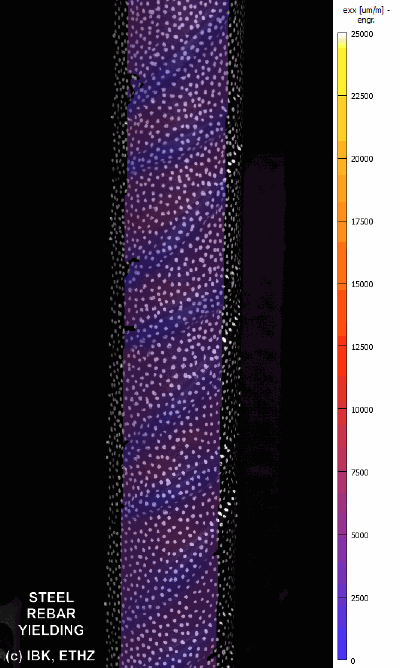Digital Image Correlation (DIC)
Application and standardization of digital image correlation (DIC) measurements for structural concrete tests
Digital image correlation (DIC) is a modern optical measurement system that allows for virtually continuous measurements of the displacement field of the entire surfaces of tested elements. Based on the displacement field, the strain field is inferred and other relevant information for the load-deformation behaviour of structural concrete can be calculated, such as crack kinematics. The post-processing of the images allows tailoring the DIC analysis depending on the known behaviour of the tested element (e.g. crack patterns). Because of these advantages, the use of DIC for structural experiments is continuously growing and complementing (or even replacing) conventional instrumentation. On the other hand, DIC has the disadvantage that the accuracy of its results is highly dependent on several aspects of the testing and the post processing phases.
This research project aims at developing a systematic procedure for defining the sensitivity and accuracy of DIC measurements on structural concrete experiments. DIC is applied to a wide range of structural applications, such as concrete compression tests, rebar tension tests, pull-out tests, tension chords and shell elements. The main parameters that determine the accuracy of each DIC measurement are examined / established for different test setups and fields of view.



Furthermore, the project is also developing a procedure for extracting crack patterns and cracks kinematics in an automated way. It enables us to deal efficiently and systematically with the large amount of data generated with DIC analysis. In a first step of this post-process, the cracks are detected at locations of high strains obtained from the DIC measurement. This analysis provides highly accurate results of the crack pattern. The use of image-processing techniques allows the extraction of crack line entities rather than independent crack points. Local full crack kinematic measurements (i.e., crack width and slip) are obtained by tracing crack branches and using the DIC displacement field. The developed crack kinematic measurement procedure accounts for local translation and rotation of crack lips. Automatically generated visualisations allow immediate interpretations of the results.

Project members
- Prof. Dr. W. Kaufmann
- Dr. J. Mata-Falcón
- M. Lee
- N. Gehri